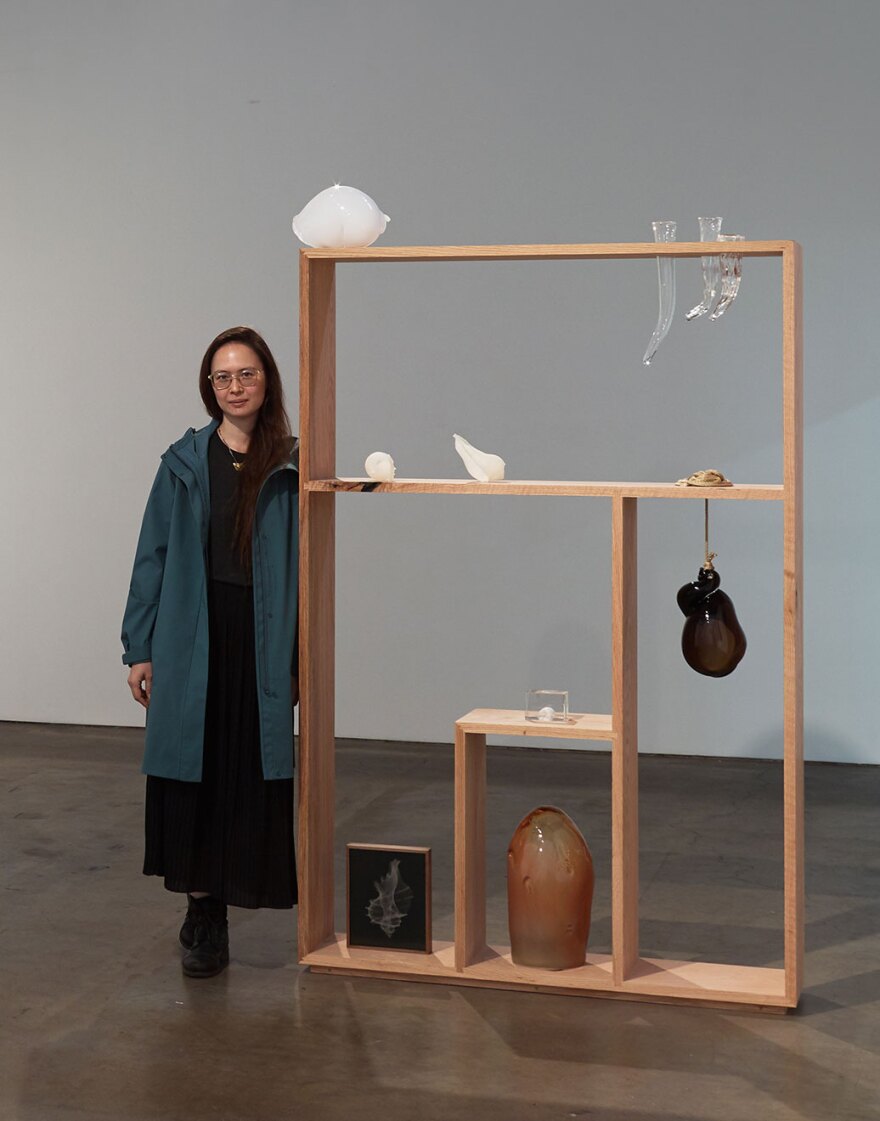"Kelly Akashi: Formations" opens this week at Museum of Contemporary Art San Diego (MCASD) in La Jolla. It's the first major touring exhibition of Akashi's work, and is organized by the San Jose Museum of Art and curator Lauren Schell Dickens.
In San Diego, it continues a streak of significant presentations of work by women at MCASD.
"It's the fourth special exhibition to be held in our La Jolla campus since we reopened, and it's the fourth monogram exhibition of important women artists," said Kathryn Kanjo, MCASD's director and CEO.

Akashi is a Los Angeles-based artist who works with a variety of materials, each forming their own through line of sorts across the exhibit: bronze castings, blown glass, ropes and wax. In this exhibit, which spans about a decade of work, object motifs include onions, her own hands, branches and portals. Conceptually, her work is grounded in memory and inheritance.
"Time is a central theme in Akashi's work," said Jill Dawsey, MCASD's senior curator. "She works with impressionable or malleable materials that carry traces of their process."
The first work you see when entering the exhibit is a tree-like sculpture, rising from a tidy circle of dirt. It's called "Conjoined Tumbleweeds," and is a recreated tumbleweed she found in Poston, Arizona.
Akashi's father spent two years in forced internment as a child during World War II, in a Japanese American concentration camp in Poston, Arizona. Poston was one of the ten American concentration camps used during World War II, holding upwards of 17,000 Japanese Americans for several years amidst Arizona's extreme temperatures. Documentation of life at Poston was made possible in part by San Diego librarian Clara Breed, who wrote letters back and forth with Poston children — the subject of a 2006 book, "Dear Miss Breed."
Akashi visited the camp herself and created a series of works about Poston. Being in Poston was a crucial intersection of her art's connection with her family's history and with time.

"In geological time it was yesterday, or less than a second ago. So maybe by going there, I can learn something," Akashi said. "10 million years ago wasn't that long ago. A human's life is often short compared to a tree's life, compared to travertine's life, and a fossil."
Kelly Akashi: Formations
Opens Sept. 21 during Free Third Thursday (10 a.m. to 8 p.m.).
On view Sept. 21 through Feb. 18, 2024.
Museum of Contemporary Art San Diego in La Jolla
700 Prospect St., La Jolla. $0-$25.
On three large, rammed-earth pedestals (which are striking works of art themselves) rest collections of small sculptures, including bronze-cast branches modeled after trees on site that she believes were also there during the internment, becoming a form of witness, Akashi said.
In one room, a crowded display of blown glass vessels represents ideas of motherhood and portals — the works look like female torsos. Against the branches and weeds in her work, the use of shiny, colored glass offers visual contrast. Above the glass mothers hangs a delicate quartz bell. When struck (by trained museum staff), the chime is soft, but its low frequency is felt in the listener's body. The sound seems endless.
"Glass has an incredible memory. Everything we do to it sort of sticks," Akashi said. If mistakes are made during the process, she said it's a struggle to erase them. So each piece of art made from glass is a record, or memorial, of everything that was done to the material.

Akashi's photography also includes chromogenic crystallographs, where she grew crystals on film before taking samples to the dark room. The colorful works underline the importance of geology and the earth's profound processes in the exhibit. Other photograms, made without the use of a camera, evoke similar geological mysteries.

"I think about time as a force that we're all beholden to and the way time materializes has always been fascinating to me whether it's been something that's materialized on me or in my flesh let's say, or in other bodies. I say that broadly and by that I mean geological bodies, other humans and other creatures."

Throughout the exhibit, curiosities like cut fingernails, dehydrated onions and looping, spiraling glass and ropes seem more like a retro specimen lab than an art gallery — but there's so much beauty, delicacy and an at-times unnerving intimacy.
One of the most striking works in the show is the almost tomb-like "Long Exposure." In one room lies a cast of her own body carved into travertine stone, surrounded by botanicals. The title references the photographic idea of vision beyond human sight.
Note: pay attention to Akashi's titles for thoughtful and often cheeky spins on her work's profound meanings — including "Eat Me," a vulva-like cast of a dehydrated onion, and "Well Hung," a collection of her bronze-cast hands, with some suspended on rope.
The exhibit is on view through mid-February, and MCASD is partnering with Pacific Arts Movement and the San Diego Asian Film Festival for programming throughout the run.






